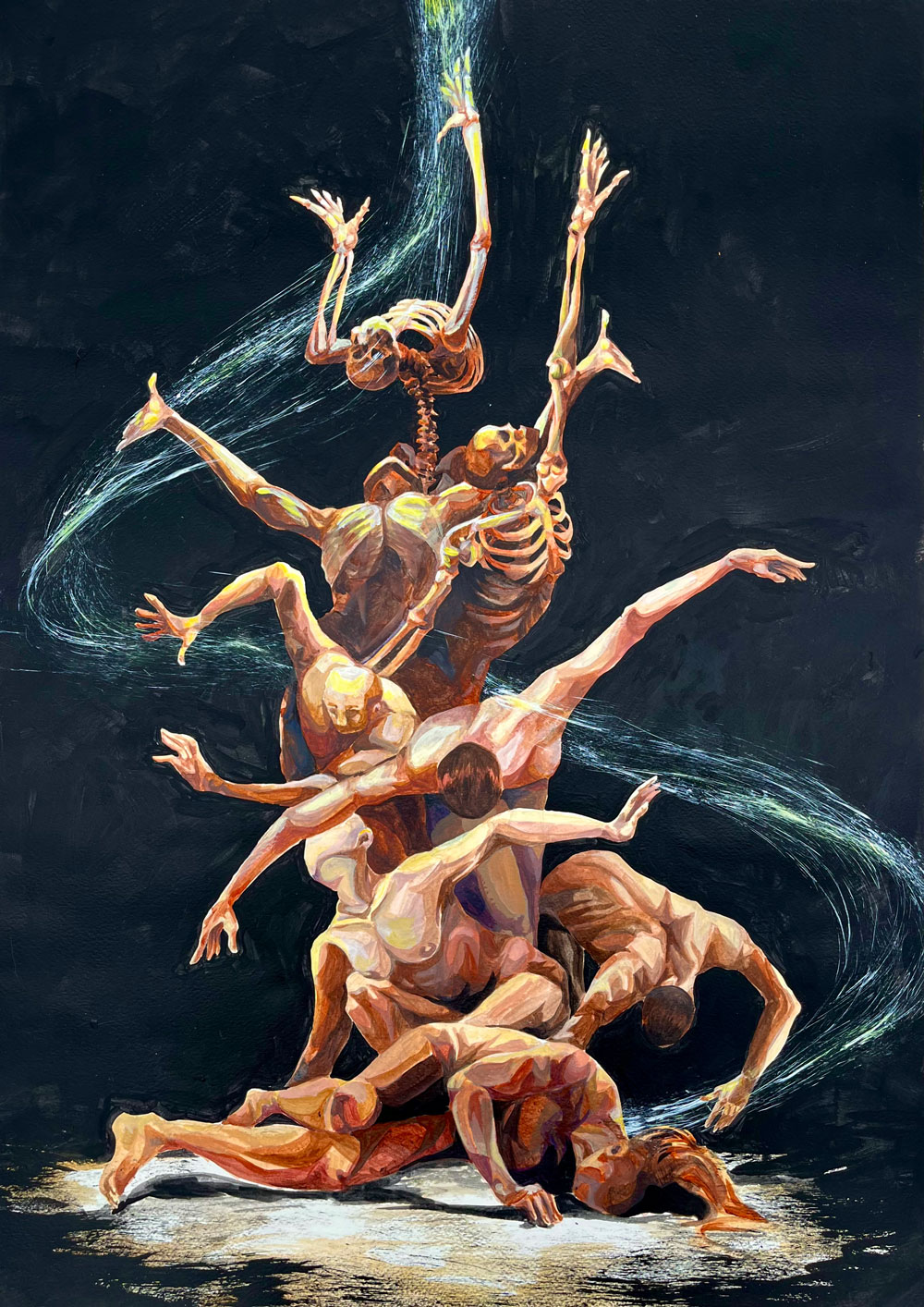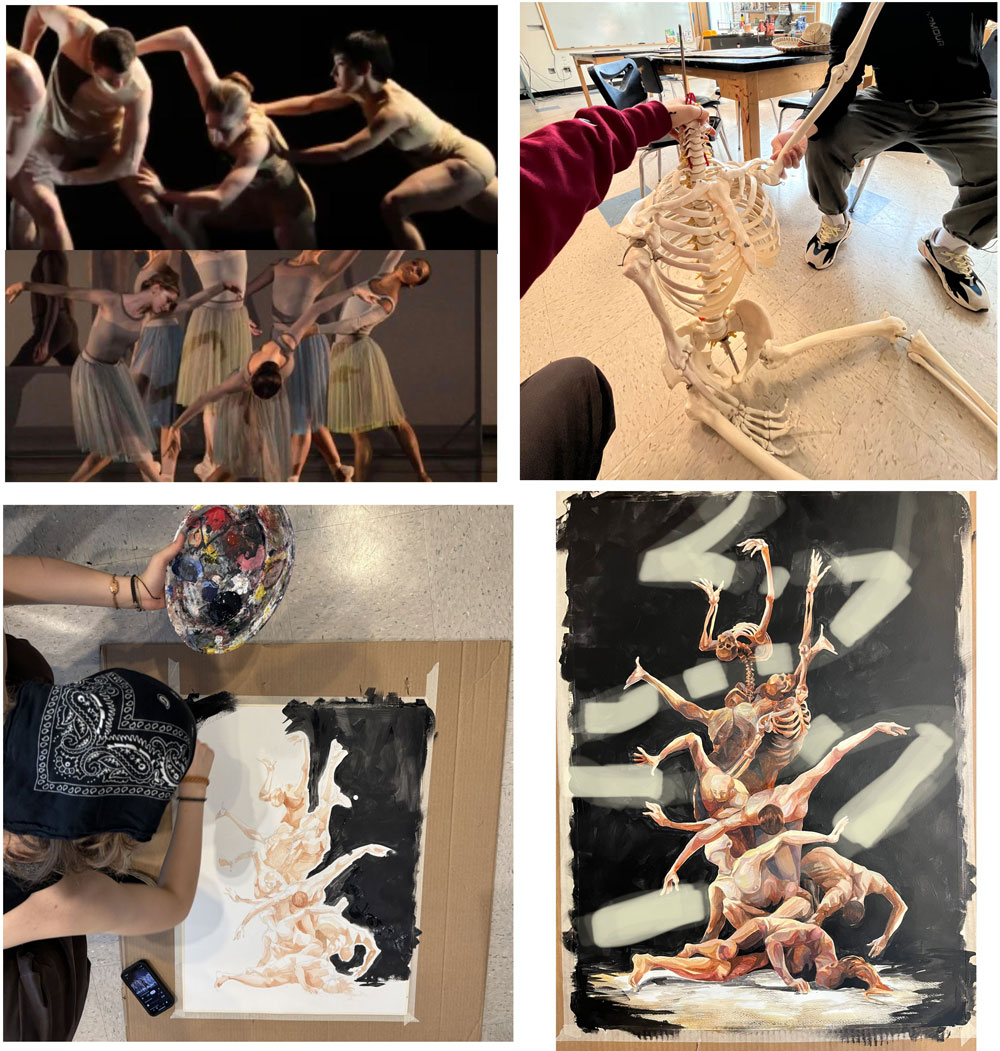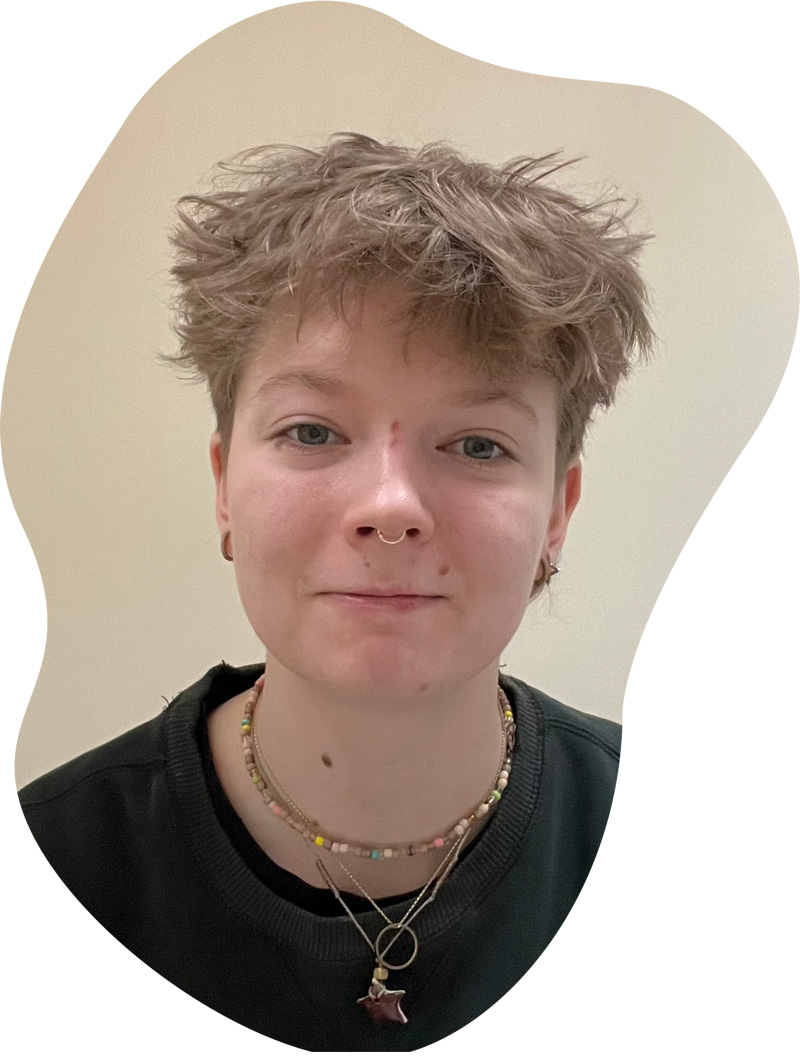

Dance of Life

Height: 30” x Width: 22” | Idea(s): To explore how intricate a body's contour can become when multiple figures are involved | Material(s): Acrylic Paint on watercolor paper | Process(es): Expanding the boundaries of bodily contour and structure by using contemporary dancers as reference | Curatorial Note:
Wonderful example of painting multiple human figures and skeletons in a theatrical environment. Love the waterspout behind the pile of figures.
Anna Kladova
Student statement
Student statement
What did you do to improve your 2-D, 3-D, or Drawing portfolio skills?
To improve my Drawing portfolio skills, I used references such as our classroom skeleton model and drew inspiration from master's works like utilizing the Zorn color pallet. I also created multiple compositional layouts for each piece to get a better range of ideas.
Does your work reference or draw on a contemporary or historical artmaking style, practice, or tradition? If so, please explain.
My work refrences bibilical Renaissance art.
Describe the critique practices and feedback you received in AP Art and Design.
The critique I would receive came from my teacher and classmates. Every few weeks my high school class would hold a formal critique where students would present their works (both finished and still in progress) and we would receive feedback on our ideas, technical skills, and if our concepts delivered the message we intended. Personally, the input that my selected work received was the idea to include skeletal forms as the figure ascended, this way, more of the human body could be visually explored.

I investigated how I can explore the human form to create interesting shapes and figures in my art.

Material(s): Acrylic paint, and reference photos | Process(es): Used contemporary dancers and skeleton models as references. Used photo editing to block in ideas. | Curatorial Note: Exciting and helpful resource images.
How did you modify or revise your artmaking direction based on feedback?
I would revise my artmaking on the feedback I received from previous artworks. For example, when my work was becoming repetitively created on bristol paper, and with one medium (acrylics) I took my classmate's feedback to try collage and working with stretched canvas. This created greater variety in my work as well as forced me to rethink my creative process.
How did your classmates help you in the creative process?
My classmates would help me by hearing out my ideas, providing their own insights, and helping me with physically posing and taking photos of models for references. For instance, to get an accurate pose for the skeletal figures in my selected work, I had to have my classmate hold the classroom Skelton model in a certain way for an extended time. My classmates would also help me think through my process by asking questions about my concepts or why I was making specific choices; this gave me a fuller understanding of my thinking and creative process.

Abygale Choi
Drawing and Painting Teacher
Newton South High School, Newton, MA
Teacher statement
Teacher statement
The AP Art and Design course supports inquiry-based personalized learning in the sustained investigation portfolio component. What strategies helped you guide students through inquiry?
We use the iceberg metaphor to consider experiences that are unique to the individual. Consequently, students compose themes and images that are unique to their experiences. Anna was quick to list a series of ideas at the beginning of the year, even going as far to help others develop their ideas, too. She combined her interest in the human form with her curiosity to master different mediums available to her, not limited to paints, markers, and dry drawing materials. Her lifelong experience as a dancer undoubtedly fueled her enthusiasm for the human figure’s full range of motion.
How did you scaffold writing into the artmaking and thinking processes?
At every midterm and final, students are asked to write objectively about their artwork. What experience is the artwork inspired by? Are there questions that you still have about what you are trying to convey? Is it an emotion or a message that you want to share? What are you most proud of and what were some challenges along the way? How did you overcome those challenges, if you did? Answering some of these questions is an opportunity to recognize repeating terms that serve as key words for their future writing. Writing about their work becomes a part of the artmaking experience in order for them to grow fluent in their artistic language.
How did you structure practice, experimentation, and revision into your AP Art and Design curriculum?
Practice comes from the layers and layers of brainstorming and research before they start a final draft. Anna loved to take a step back from her piece, take photos of it, and observe what could be improved. She revised her work digitally before committing to it physically. Anna naturally experimented with combining nontraditional mediums like spray paint with more traditional mediums like charcoal or markers. Students are encouraged to consider their investigation topic in relation to all areas of their life, including other subject areas of study and hobbies. Their investigation becomes an idea that is visited regularly during their day, not just during class time.
How do you support your students in the Selected Works portfolio component?
I prompt students to think of how they can “flex” their artistry through a series of pieces. These pieces can be made inside or outside the classroom, showcasing their ability to use compositional guidelines with various traditional and nontraditional materials.
What did you learn from working with your student?
Watching Anna grow in her commitment to art making, creating, and learning over a span of four years reminded me that some students are truly born to create with their hands. She learned to see and create color, challenge forms, and stretch concepts as she painted and drew. Everything Anna made, whether it may have been her strongest suit, drawing and painting, or a new endeavor, like whittling wood and ceramics, was done with utmost craftsmanship and curiosity. Other students who witness Anna’s dedication to creating are inspired to do likewise.

Talia Etedgee Brown
Department Head of Fine and Performing Arts
Newton South High School, Newton, MA, USA
Leader Statement
Leader Statement
What are you most proud of regarding your school’s AP Art and Design program, student, and teacher?
At Newton South our visual art teachers foster a supportive and creative art studio environment. Students are encouraged to bring their personal stories and identity into their work. As you walk though Ms Choi's classroom, each piece of student work is unique and an independent expression of self. Anna Kladova thrived in this environment and her work always captured attention and curiosity.
What do you do to support visual arts programming in your school?
We support the visual arts program here at Newton South by supporting the professional growth of our arts teachers and working closely as a team. Our art teachers like Ms Choi are professionals themselves in their craft. Our hallways gallery walks are titled "See and Be Seen" and we rotate our gallery work all year showcasing the amazing work of students and allowing the whole student body to see the work. This celebration of the arts building wide helps promote a culture of artistic appreciation.
What is your advice to other school leaders on how to support an AP Art and Design program?
Offering foundational courses in the arts that guide students on their journey to AP level arts courses are instrumental in allowing all students access to advanced course work. That, and hiring and retiring highly qualified artists who are skilled, trained teachers has led to high student engagement here at Newton South in the arts.

Anna Kladova



